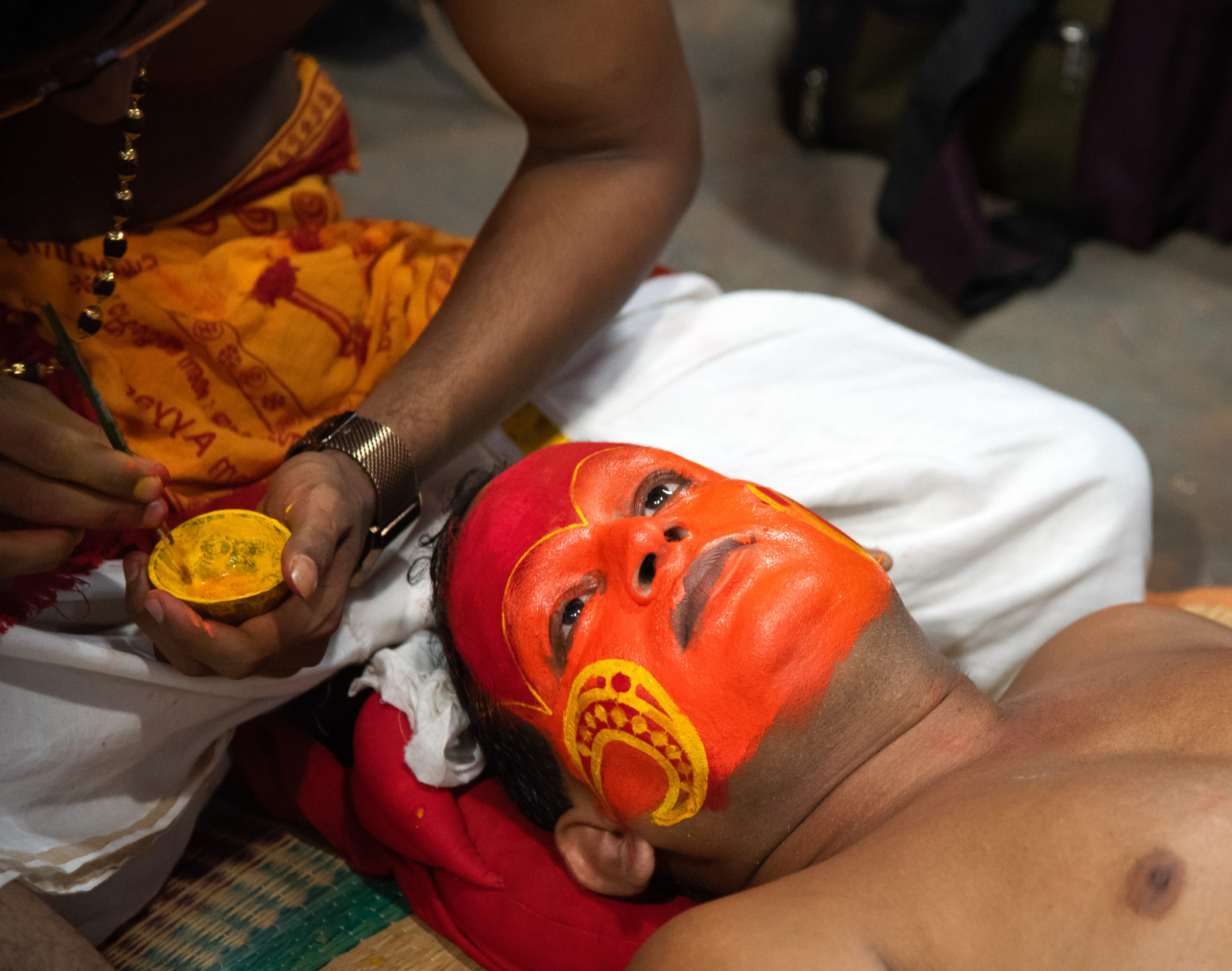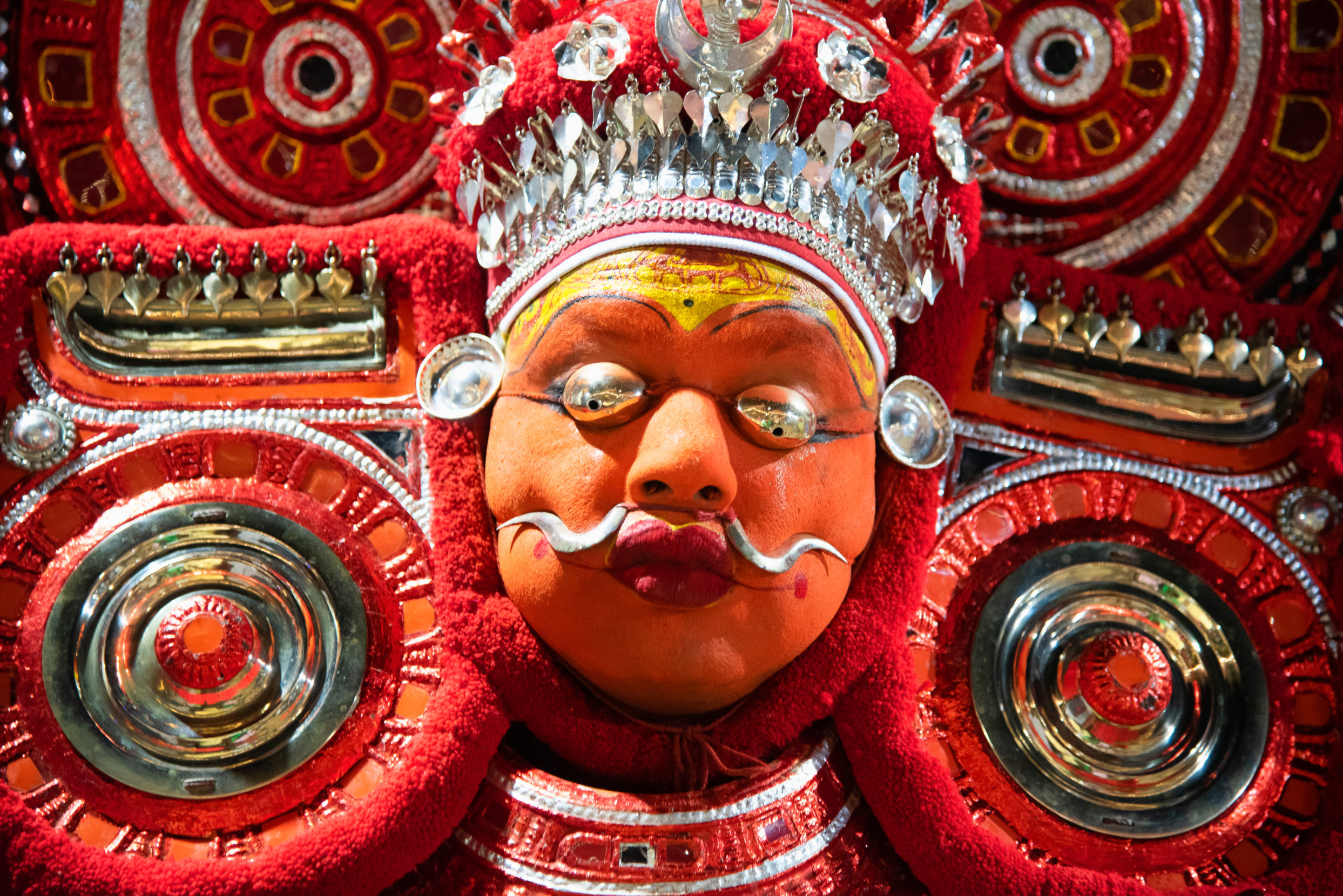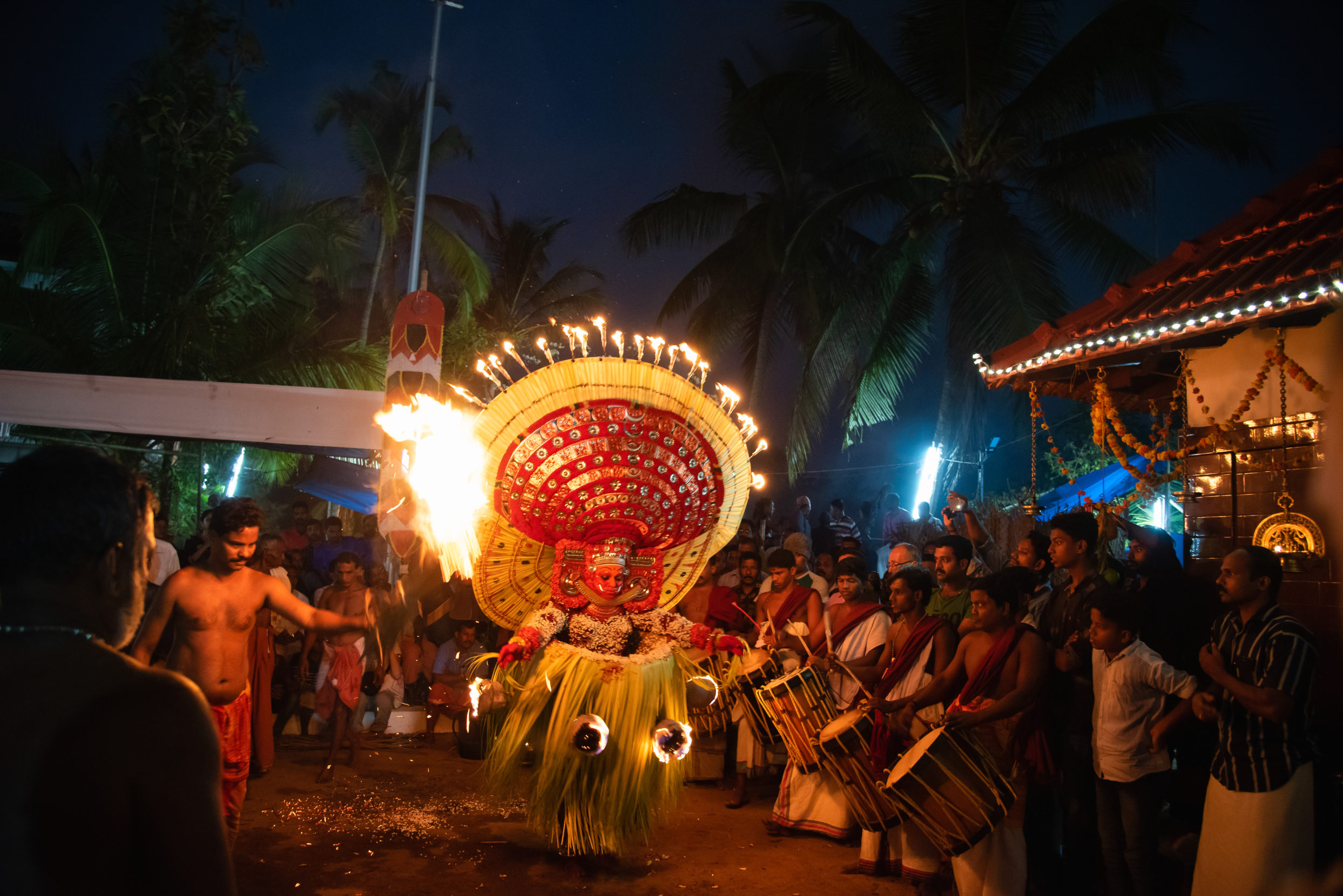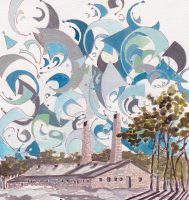Support Hidden Compass
Our articles are crafted by humans (not generative AI). Support Team Human with a contribution!
A tobacco-colored gloom pervades the temple courtyard. Bare-chested men, knee-length white lungis draped around their midriff, run through the dark. Their sweaty torsos gleam in the faint light of burning embers, neatly mounded nearby, and a scarce scattering of oil lamps.
Slow drumbeats rumble through the chaos, the rhythm rapped out by a squadron clad in white. Onlookers gather at the perimeter of the courtyard.
Without notice, the tempo increases, cuing those gathered to fall silent, as the beats build to a feverish crescendo. A blood-curdling yell rises from the shadows behind the clearing, followed by maniacal laughter.
The crowd recoils with a collective gasp as the incarnation of Puthiya Bhagavathy bounds into the courtyard. Red paint crisscrosses the goddess’s chest and muscular upper arms; orange splotches streak her face. Black paint encircles her bulging, unblinking eyes, which stare belligerently.
She begins strutting around the courtyard, her movements abrupt and apparently uncontrollable. I watch in awe, recognizing the form of the person I stood beside just moments before. But they are no longer the same — that much is clear.
~~
A couple hours earlier — sometime after 3 a.m. — I had arrived at a kavu, or sacred grove, inside a small forest outside the town of Kannur, along the coastal Malabar region of southwest India. Under a purple sky, in the middle of a small clearing hemmed in with a humid, tropical forest, a stocky, bleary man sat ceremonially on a chair. Sweat lines trickled down his face, smudged in red and black.
I turned to Rejith, my driver and guide, a lanky, middle-aged man with a thick mustache. Moments earlier, Rejith told me, this weary man before us would have staggered across the clearing as Theechamundi, a demon-slaying Hindu goddess.
He hadn’t been performing. As an oracle, he had channeled Theechamundi, his body a mortal frame for the deity’s incarnation.
The oracles, in their exalted state of trance, are believed to acquire divine powers to heal and foretell the future.
This is Theyyam, known across India and beyond as one of the most vibrant folk traditions to revere living gods — and what drew me to these pitch-dark streets. Dating back at least 1,500 years, the sights and sounds of Theyyam transform temples and kavus such as this one. Theyyam festivities last from October to May, with remote villages dotted across rural Malabar serving as a rotating stage for the syncretic ritual.
As a photographer, I find the visual spectacle irresistible. But that’s not what brought me here; my native India is rife with mesmerizing traditions to document. I came because I sought to understand the transformation that happens beneath the elaborate costumes and makeup of Theyyam — what has compelled a long file of devotees to patiently wait in front of the potbellied man before me.
He held a brass bowl, filled with a rice paste mixed with yellow turmeric powder — a sort of sacrament with which the incarnate deity blesses the worshippers. Rejith explained that the people gathered here had come from the villages around the forest to offer their prayers and narrate their woes to the oracle. They would leave some money on a brass plate kept on the side before continuing on their way, their faces brightened with words of hope.
Upon his turn in line, a portly man of about 50 clasped his hands and mumbled a few tearful words to the oracle, before he lay prostrate at Theechamundi’s feet. Rejith discreetly pointed towards the white thread across the man’s bare upper body. The sacred string marked him as a Brahmin — the highest caste position in the Hindu hierarchy, from which centuries of priests originated.
I had been told that in this part of India, some of the staunch Brahmins still resist sitting together alongside people without their privilege. Now, with his face down on the dusty ground, the man cried and implored the oracle, his hands folded over his head.
For the time being, it seemed, even caste bowed down before the deity.
~~
The day prior, during an extravagant home-cooked meal at the breezy, cavernous veranda of Rejith’s house, coconut and tamarind had danced across my palate as my mind buzzed with the complexities of this ancient tradition.
“Theyyam is the corruption of the word daivam, which means god in Malayalam,” explained Rejith’s wife, Reeja. Her hair bedecked with fragrant jasmine flowers, she ladled tangy fish curry onto my plate.
Her husband nodded along, explaining how the oracles, in their exalted state of trance, are believed to acquire divine powers to heal and foretell the future.
I asked, tentatively, if the practitioners always invoke Hindu gods and goddesses.
“Aiyo!” exclaimed Reeja, her eyebrows shooting high. This ubiquitous South Indian word can express anything from delight to disapproval, but her husband’s quiet smile told me I could not have been more wrong.
Reeja, who wrote a dissertation on Theyyam, went on to explain that it extends beyond Hinduism. Major Hindu gods do appear in Theyyam traditions, bringing to life Shiva, Vishnu, Yama, different forms of Bhagavathy (Mother Goddess), and others with ritualistic dance, music, and narrative chants. But, Reeja emphasized, local deities, mythical beings, and even ancient war heroes make appearances, too.
“In fact,” she said, her voice animated, “earliest theyyams date back to a time when paganism was the commonest form of worship. The cosmology of Hindu gods and goddesses was a later addition.” Speaking in a curious blend of Hindi, Malayalam, and English, she turned to her husband whenever in want of the right word.
I watch in awe, recognizing the form of the person I stood beside just moments before. But they are no longer the same — that much is clear.
A round of freshly ground filter coffee was poured, and our conversation turned to the part of Theyyam that most intrigued me: its ephemeral reversal of social order.
Caste structure doesn’t factor in my life in Kolkata. But here in the rural belts of Malabar, I am told, this hierarchy has remained rigid, despite Kerala’s progressive reputation. Amid this enduring social reality, the underprivileged section, mostly from the lower rungs of the caste hierarchy, often faces prejudices and limitations.
And yet it is from these marginalized communities, engaged mostly in menial day jobs, where Theyyam practitioners traditionally hail. Centered on dancers from the lowest castes, Theyyam rituals subvert the hierarchy by flipping it completely.
Rejith explained how Theyyam acts as a sort of social commentary. The elaborate costumes and ritualistic dance and music provide cultural cover, as well as societal context. Narrative chants give voice to deeply rooted inequalities, with many of the 400-some individual theyyams telling ancient stories of oppression that have been passed down orally through the generations. It’s more than a theater of the downtrodden, though.
From the depths rises resistance.
~~
After a few hours of sleep at my hotel, Rejith steered me through the thicket, past the queue for Theechamundi, to a small, makeshift hut behind the shrine. At the rear of this green room of the gods I found Vellan, who has been a Theyyam practitioner for over a decade. I was told he knows a smattering of Hindi, and I hoped to catch a quick conversation with him before Puthiya Bhagavathy entered his flesh-and-blood template.
A benevolent mother goddess, Puthiya can cure deadly diseases — but, Rejith had just informed me, can get temperamental if her thirst is not quenched with fresh chicken blood.
Vellan lay still on his back, eyes closed, his head resting on the legs of a middle-aged man using the stem of a coconut leaf to draw meticulous motifs and spirals on Vellan’s fleshy cheeks, coated with fluorescent orange paint. Called mukhathezhuthu, this face painting is an intricate art form. The accuracy of the design is said to play a critical role in the transcendence.
I made myself comfortable beside Vellan, taking care not to upset the assorted trays and pans of vegetable dyes for the makeup.
A few awkward moments passed, until I broke the silence with a hello.
Vellan slowly opened his eyes and nodded.

A makeup artist applies intricate designs in turmeric paste onto the face of a Theyyam practitioner. This distinct facial art is known as mukhathezhuthu and its methods are passed on orally. Photo: Sugato Mukherjee.
Watching him closely, I took in the nondescript face underneath the adornments. I thought about the slow metamorphosis I could see on the surface — and the deeper one I could not.
“How do you prepare yourself for Theyyam?” I asked him, taking care to insert Malayalam and English words in my Hindi query. The makeup artist shifted to Vellan’s chest and began applying a fresh paste of turmeric powder.
Vellan allowed a tolerant smile through his heavily rouged lips and began speaking, his voice quiet but clear as he explained that his transformation began long before he entered this hut.
In the weeks leading up to the “day of the possession,” Vellan told me, he adhered to strict rules to prepare his body. His routines became rituals of purpose, as they have for each of the past 14 years.
“I have meditated every day for the past six weeks, have not touched meat or alcohol, and have not slept with my wife,” he explained. All the while, Vellan continued to spend his days digging wells, mostly for the homes of affluent members of the upper castes in and around his village.
Our conversation paused as the makeup man began working on Vellan’s face again, deftly drawing jet black paisleys around his closed eyes.
As I watched, I found myself thinking about Vellan’s inherited place in society, and the intensity of that dichotomy. I mulled over the idea of asking him about his usual interactions with Brahmins, and what experiences he may have had with “untouchability.”
Narrative chants give voice to deeply rooted inequalities, with many of the 400-some individual theyyams telling ancient stories of oppression that have been passed down orally through the generations.
But a couple minutes later, when his face paint was complete, I detected a palpable change in Vellan. A strange, faraway look had clouded his closely set eyes, and his smile was fixed, absentminded. I understood I did not have much time left for questions.
I asked if he could tell me about the transformation itself. For a minute, Vellan seemed lost deep in thought, then shook his head and answered slowly.
“I can’t really remember,” he said. “Except the dard — pain. A sharp pain. After that, I don’t remember much.” By the time he returns to consciousness, Vellan said, he would be resting on a stool with a long queue of devotees standing before him.
“When is this? The pain, I mean?” I whispered, afraid to break his flow. From the corner of my eye, I could see the makeup man had stopped his work to listen intently.
“It is when they hand me the mirror. When I look into it and see the face of the god in it. The music and the chants start hammering inside my head, and then comes the pain. It hurts a lot. After that, I don’t know … ” Vellan’s voice trailed off.
~~
In the courtyard outside, which was now quiet, a watery, pre-dawn light broke through the darkness. The villagers silently waited for the mother goddess to emerge.
A man came over and had a word with Vellan. The makeup was now complete. Vellan stood up, and three men crowned him with a huge, red-gilt headpiece, studded with glass beads. A flowing green skirt was eased on to his lower body. Metal orbs were fitted on his chest and a silvery pair of fangs put in his mouth.
Finally, as he sat upright on a chair outside, a small mirror was placed in his hands. I watched intently. Suddenly, Vellan’s body bent over, as if hit sharply, and trembled. With an otherwise expressionless face, his sad eyes took on a charged look.
Handed a large, unsheathed sword, the being before me grunted approval in an almost bestial fashion. The quiet man with a slightly melancholic face that I had been talking with was no longer present.

During Theyyam, elaborate headgear tops off a head-to-toe ensemble integral to each oracle’s transformation. Photo: Sugato Mukherjee.
~~
The drummers’ beat, loud and abrupt, has an almost physical impact. Red-faced, black-eyed, and with an open sword in hand, the deity twists and turns frenetically. A raspy voice rants with rage. The weight of the gigantic costume shifts from one foot to the other.
“The oracle is fully seized by the god now,” Rejith whispers from behind me. Puthiya Bhagavathy has descended on the temple courtyard. Holding the goddess upright is a man on either side. For now, only these kamerans, or servants, are entitled to touch her.
We fall silent as another terrifying shriek fills the night. Puthiya rushes through the courtyard with several flaming torches affixed to her waist dress, a flowing sheath of tender coconut leaves. The dress flows high as she twirls around and jumps, her movements so fast that the kamerans cry out, trying to keep up with her pace. The air thickens with the smell of burnt leaves, camphor, and ghee. The heat becomes unbearable for me, even as I crouch with my camera at least 20 feet away.

Encircled by flames, the incarnation of Puthiya Bhagavathy takes command of a temple courtyard along the coastal Malabar region of southwest India. Photo: Sugato Mukherjee.
In a land still rife with caste divisions, Vellan has likely faced prejudices all his life. He is a laborer, digging out a humble life.
But for now, the gathered devotees reverentially rise before Puthiya, hands folded and heads bowed. Thanks to a rite that originated more than a millennium ago, Vellan has reached the realm of the divine. He is now the incarnation of Puthiya Bhagavathy. She showers the crowd with rice offerings and blessings in a thick, hoarse voice that is entirely different from Vellan’s own.
In this moment, at once fleeting and forever, transcendence is his.
Sugato Mukherjee
Sugato Mukherjee is a Kolkata, India-based photographer and writer whose work on the sulfur miners of East Java was recognized by UNESCO.



